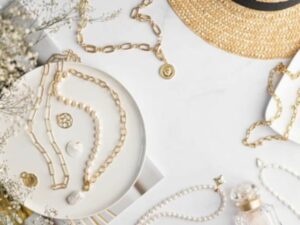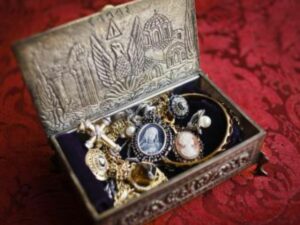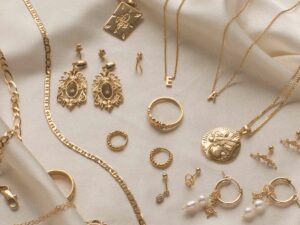In recent years, advancements in science and technology, coupled with rising economic prosperity, have led to increased consumer expectations for high-quality jewelry. As a result, the industry must not only focus on quality and craftsmanship but also innovate in terms of design, color, and aesthetics. This integration of aesthetics and art into jewelry design presents new challenges for the industry.
In recent years, advancements in science and technology, along with improvements in economic conditions, have led consumers to seek not just high-quality jewelry but also excellence in craftsmanship, style, and color. This paper discusses the imperative of incorporating aesthetics into jewelry design.

Jewelry plays an important role in people’s lives. As a kind of luxury goods, appreciating them is not just from a simple economic perspective. Rather, it is from the perspective of aesthetics and art that one understands their connotation and culture.
In the dazzling world of jewelry, all kinds of pieces not only contain profound culture but also unique aesthetic art. Through careful design, luxury jewelry presents people with a high-end and graceful attitude. It represents not only an ideal way of life but also serves as an aesthetic and artistic examination.
1. Overview of Jewelry Design
People have used jewelry for a long time. Since the Paleolithic Age, ancestors have worn animal teeth, shells, beads, and other objects as jewelry. With the evolution of human beings and the continuous changes of dynasties, the types of jewelry are also constantly changing. In order to meet the aesthetic requirements of various dynasties and generations, jewelry designs are constantly being refined and improved.

Judging from current designs, the inspiration mainly comes from nature, graphics, and architecture. Styles, symbolic patterns, colors and materials, avant-garde and trends, personal stories, etc., all play a role. The design and production process of jewelry is mainly as follows: thinking, gathering information, sketches, design drawings, pattern making, corrections, and the finished product.
First of all, the designer needs to combine various sources of inspiration to imagine. By collecting corresponding information, the concept he wants to express can be displayed through sketches. Secondly, the designer uses the sketch as a blueprint to continuously improve areas that are not satisfactory, modifying until fully satisfied, and finally, the design is presented in three views.
According to the design drawings, models are first made. After various processes and modifications, they eventually become the finished product.
Received Date: 2013-09-23
About the Author: Wu Liang (1990— ), male, from Xuancheng, Anhui, undergraduate student, research Direction: Jewelry design.
Jewelry has been accompanying the development of mankind since its birth. As a witness to the history of human civilization, it is also a witness to the development of human science, technology, and culture. Progress begets progress; therefore, its functions and connotations have also undergone tremendous changes.
Whether the jewelry is traditional handicraft or mass-produced, the biggest feature of the produced jewelry is that it is mainly decorative and beautiful. In addition, it also serves as a symbolic sign of power, wealth, courage, and strength.
In recent years, with changes in material civilization and people’s lifestyles, society is becoming increasingly diverse in culture. Jewelry design is also regarded as a way to express personality and improve life, presenting art treasures of quality that are edifying and beautifully presented.
2. The Importance of Aesthetic Art in Jewelry Design
The main function of jewelry is decoration, achieved through style, color, and differences in design in terms of materials and craftsmanship. Through the wearer’s reasonable matching, it can play the role of compensating for shortcomings and highlighting advantages.
In recent years, with changes in people’s living standards and consumption concepts, there have been increased requirements for the beauty of jewelry. It is not only required to play a decorative role but also to carry a certain amount of culture, art, and spirit. This brings new challenges to jewelry design.
Based on the above factors, the rational application of aesthetic art in jewelry has become an inevitable trend. Through aesthetic design, jewelry can be combined with various characteristics. It reflects the enjoyment of cultural beauty, artistic beauty, emotional beauty, and other inner beauty that jewelry brings to people.
Designers combine aesthetics with art and the full application of technology to give jewelry the most intuitive visual enjoyment through beautiful shapes. They then express their unique spiritual connotation with accurate cultural positioning and characteristics, thereby reaching the highest level of aesthetic design.
|
Factor
|
Description
|
Importance in Aesthetic Art
|
Practical Tips
|
| Symmetry |
Balanced proportion and arrangement. |
Creates a sense of harmony and elegance. |
Use a ruler or digital grid for precise measurement. |
| Material |
Type and quality of metals, gemstones, etc. |
Defines the overall look and feel of the piece. |
Choose materials that resonate with your brand, like durable and sweat-resistant options. |
| Color Scheme |
The color palette used in the design. |
Evokes emotional responses and attracts attention. |
Use colors that align with the psychology of your target audience. |
| Craftsmanship |
Skill in construction and finish. |
High craftsmanship ensures longevity and adds value. |
Invest in skilled artisans or quality manufacturing processes. |
| Design Complexity |
The intricacy of the design elements. |
Can make a piece stand out but may also overwhelm. |
Find a balance between complexity and minimalism based on your audience’s preference. |
| Uniqueness |
The degree of originality in design. |
Sets the piece apart from mass-produced items. |
Incorporate unique elements like custom engravings or distinctive shapes. |
| Versatility |
How easily the piece can be paired with different outfits or settings. |
Increases the item’s utility and appeal. |
Create pieces that can transition from the gym to social settings easily. |
3. Aesthetic Discussion of Jewelry Design
The so-called “beauty” refers to the attraction or value of an objective object. Jewelry, as a form of human beauty that embodies the aura of heaven and earth, has been favored by people since ancient times. With the improvement of people’s aesthetic level and the universalization of wearing jewelry, attention has also begun to be paid to the design of jewelry.

The design of jewelry is not only the designer’s personal aesthetic expression but also requires comprehensive consideration of different wearers and types of jewelry. Only then can we design products that represent aesthetics, personality, and cultivation and are suitable for different occasions.
Therefore, the aesthetics of jewelry design are mainly expressed through style, combination beauty, material beauty, color beauty, and craftsmanship beauty.
3.1 Beautiful Jewelry Designs
The key point of style beauty in jewelry is the beauty of the image, which is inseparable from lines. Perceptual effects such as shape and color impact people’s senses, affecting their thoughts and giving them a feeling of beauty. In jewelry design, style beauty is mainly reflected in the following four points:
Symmetry and Balance
Although the shape and decoration of each piece of jewelry differ, there are still areas of consistency within these differences. This consistency should mainly be reflected in two aspects: symmetry and balance. Symmetry refers to having a line serving as the central axis, equal on the upper and lower, left and right sides.
Balance refers to a sense of stability in jewelry, for example, pairing warm K gold with rubies or cold platinum with sapphires, and surrounding large diamonds with colored gemstones or small diamonds. Such a design can be called balanced.
Harmony and Contrast
Harmony and contrast are two opposite states. Harmony mainly refers to the expression of consistency within differences, while contrast refers to the expression of “difference” within differences. In harmonious jewelry design, two similar materials are juxtaposed, such as blue and green or adjacent colors like red and orange, purple and red.
Through combination and inlay methods, this creates a sense of coordination and integration. In contrast design, two unrelated materials are juxtaposed. For example, inlaying rubies, sapphires, and diamonds on a single piece of jewelry, or setting black pearls in platinum, or grouping large gems with small gems of the same type. This design method gives people an active, distinct, and eye-catching aesthetic.
Diversity and Unity
In jewelry design, diversity reflects the vast differences in the personalities of various ornaments, while unity refers to the commonality or overall connection of each unique ornament. Diverse and unified design mainly refers to the way several beautiful styles are organically combined to form a design that has complex and diversified characteristics, yet does not exhibit overall chaos or disorder.
The Proportion is Appropriate
Appropriate proportions in jewelry design mainly refer to a symmetrical relationship between the whole and part of something. According to the ancient definition, “Increasing one point makes it longer, subtracting one point makes it shorter,” this is the essence of proportion.
Therefore, to fully express the style and beauty of jewelry design, appropriate proportions are important. However, some designers specifically use proportional imbalance to create jewelry with unique shapes, uniqueness, and personality. As long as it has a certain scientific basis and reasonableness, this kind of imbalanced design method can also be tried.
3.2 The Beauty of Matching Jewelry Design
A person’s temperament, accomplishments, physical characteristics, skin color, body shape, age, and occupation all influence how different people wear jewelry. Therefore, designers need to fully investigate and analyze these factors, integrate the wearer’s information, and design with corresponding clothing to meet the aesthetic requirements of the design.
Jewelry design, as a comprehensive art, requires consideration of various factors such as season, occasion, and clothing matching. In addition to these, designers also need to consider the special connotations of jewelry and jewelry shapes, targeting the special features of the wearing parts such as the face, ears, neck, chest, wrists, and fingers.
The design should be such that the jewelry complements the wearer and serves to make up for shortcomings and highlight decorative effects.
3.3 The Beauty of Materials in Jewelry Design
Depending on the materials used, jewelry design mainly focuses on two aspects. One type of jewelry emphasizes fashionable and unique styles; the other focuses on craftsmanship. Among them, the former commonly uses materials like resin, plastic, and glass. These materials are relatively inexpensive and offer bright colors.
The design mainly highlights exaggerated shapes and novel styles. This kind of jewelry is also called fashion jewelry and is mainly representative of current trends. The latter type uses more expensive raw materials such as gemstones, diamonds, gold, platinum, and pearls. This kind of jewelry has the characteristic of preserving value, as the raw materials themselves already determine the value of the finished product.
Therefore, in the design, the emphasis is mainly on the fineness of processing, while changes in style are secondary. When designing, attention must be paid to showcasing a sense of nobility through the beauty of the material.
3.4 The Beauty of Color in Jewelry Design
The effect of color in jewelry design is also very important. Different colors have different emotional impacts on people and can be used to express various qualities such as warmth, softness, weight, strength, brightness, calmness, beauty, and rusticity. Color is the first visual experience that jewelry offers to consumers, and its different brilliance and hues play a key role in consumer choice.
Differences in age, ethnicity, gender, consumption level, and region all influence consumers’ preferences for jewelry colors. Therefore, when designers create pieces, they combine different ideas based on people’s varying psychological concepts.
Different colors are designed to suit different groups, resulting in dazzling and vibrant jewelry. Such colorful pieces not only fully embody the beauty of color but also attract a broader range of consumers.
3.5 The Beauty of Craftsmanship in Jewelry Design
The aesthetic expression of jewelry design depends not only on the beauty of style, matching, materials, and color but also on its artistic beauty. The quality and value of jewelry can be better reflected only through skillful and advanced craftsmanship.
The beauty of craftsmanship in jewelry mainly comes from the design positioning, materials, and technical methods used. The artistic beauty of jewelry is determined by four production stages:
- The Starting Stage of Jewelry: Generally, there are two methods of jewelry production: brain-printing and manual molding. The quality of the master plate in the molding stage will determine all subsequent processing steps. Therefore, extra attention should be paid to the process at this stage.
- The Production Stage of Jewelry: Each finished piece of jewelry has to go through several or even dozens of complicated steps. Both the quantity and the overall quality of the jewelry are inseparable from the strict control of every link in the production chain.
- Jewelry Surface Finishing Stage: Jewelry processed into finished products also requires additional steps like electroplating, casting, acid etching, and sandblasting. These surface treatment processes are used to achieve a perfect surface effect. Therefore, the process of finishing the surface of jewelry is also a key point.
- The Special Process Stage of Jewelry: Special jewelry craftsmanship generally refers to unique traditional crafts and production methods, such as spot copper craft, cloisonné craft, and filigree inlay craft. Some of the more special pieces of jewelry are processed through this stage to fully demonstrate their craftsmanship value and beauty.
It is around and within these nodules that copper is enriched. Therefore, it can be said that the formation of copper-bearing sandstone-type copper deposits in the Ming Dynasty was initially caused by the deposition of copper minerals to form copper-bearing sandstone.
Under the influence of hydrothermal fluids, copper within the sediments dissolved, migrated, and became enriched. Structures generated by supergene processes are common, indicating that secondary changes in copper minerals are evident, although no obvious zoning phenomenon is formed.
Migration and Mineralization of Mineral-Forming Minerals: From a regional perspective, there are favorable mineralization geological backgrounds and conditions. The early geological environment and volcanic eruptions brought up rich minerals from the underground hydrothermal belt. Various orogenic and tectonic movements then activated, transferred, and restructured the original minerals, creating new allocations.
The fault structure in the mining area also provides opportunities for the enrichment of copper ore. Ore-containing solutions migrate in the fracture zones and form in areas favorable for mineralization. This rich mineralization led to the formation of today’s mineral deposits.
Copper minerals in the mining area are mainly concentrated in fault fracture zones, fissure surfaces of small fissure structures, and rock strata surfaces and bedding surfaces, further explaining the formation and subsequent structure of the copper ore body. The superposition is closely related.
4. Knot Language
In order to achieve the dual beauty effect of external and internal aspects in jewelry, the designer’s understanding of the beauty of styles, combinations, colors, materials, and craftsmanship is essential. The full display of beauty allows contemporary jewelry to align with cultural and fashion concepts. While serving as a perfect decoration, it reflects the progress and development of the times.
References:
Li Chunxiao. “Incomparably Stunning Chinese Red Rhyme — Ruihong Jewelry.” Big Vision, 2010, (35): 87.
Zou Ningxin. “Japanese Humanities and Aesthetics in Modern Jewelry Design.” Art Design Research, 2010, (2): 84-86.
He Liqun. “Identification and Processing of Jewelry and Jade.” China’s New Technologies and New Products, 2010, (3): 134.
Wang Zhijun. “A Preliminary Study on Traditional Jewelry Art Design.” Going Abroad and Employment (Employment Edition), 2011, (6): 68.
Li Yan. “Bucherer Gemology Center.” Design, 2013, (3): 158-159.
5. Conclusion
The Jiaomaidi mining section of the Changqing copper mining area in Weining County is a sandstone copper mine. The main ore-bearing strata are gray-green fine sandstone and silt in the first and second sections of the Feixianguan Formation. In terms of lithological strata, it is closely related to fault structures and small fissure structures.
The gray-green sandstone, fault fracture zones, and small fissure-intensive zones in the Feixianguan Formation consist of medium clastic or fractured structural rocks. These are rich in plant fossils and pyrite. Locations with strong sedimentary layers should be the focus of the next step in prospecting.
References:
Xue Bugao. “Research on the Metallogenic Rules of Emeishan Basalt and Basalt Copper Deposits.” Chemistry, Industrial and Mineral Geology, 2007, 29(2): 88-97.
Luo Xiaohuan, Liu Xunfeng, Wang Yuqiong, et al. “Basalt Copper Deposit in Weining Area, Guizhou: Qualitative Characteristics.” Guizhou Geology, 2002, 19(4): 215-220.
Shi Shanhua. “Geological Survey of the Jiaomaidi Mining Section, Changqing Copper Mining Area, Weining County, Guizhou Province: Report.” Guiyang: Guizhou Geological and Mineral Resources Development Corporation, 2008.
(Continued from Chapter 57, Page)
For example, in the basic information module of this system, after adding a device, the device can then be prepared to perform corresponding operations. These operations can be viewed in the asset equipment browsing module, indicating that the system functions correctly.
4.2 Data Validity Inspection for Asset Equipment Management
Data validity testing means that every data input into the system must be correct and valid. Validity verification can be performed through rules restricted by the database design. Both the Asset Equipment Management System Requirements Form and the data entered in the fields must be valid.
References:
Wang Rui, Yu Su, Zhang Yu. Complete Manual of Visual C++ Database System Development. Beijing: People’s Posts and Telecommunications Press, 2006.
Bags Flood Letter, Beg Yan Red. Business Accounting. Beijing: Economics Zico Study Out Version Society, 2005.
Sa Shixuan, Wang Shan. Introduction to Database Systems. Beijing: Higher Education Publishing Society, 2005.
Wang Junwei, Shi Chuangming. SQL Server 2005 Chinese Version Database Management and Application Standard Tutorial. Beijing: Tsinghua University Press, 2006.
Zhu Shaomin, Zuo Zhi. Software Process Management. Beijing: Tsinghua University Press, 2007.



